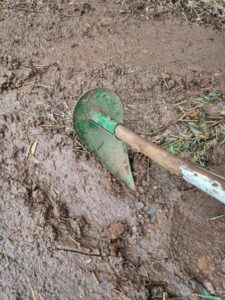
Back to basics with small tools
By Patrick Regnault
Small tools are the basis of our trade. Secateurs, pruning and grafting knives, shovels and spades, picks, and hoes, and so much more. Some of the small tools have been used for centuries and reached their final forms a very long time ago. The choice of tools for a given task and the manner they are used can greatly influence the cost of a project and the welfare of those using them.
Advances in technology has brought some lighter, less noisy tools. Battery operated tools such as mowers, hedgers, whipper-snippers, and chainsaws, are often lighter and easier on the body than their petrol counterparts. Motorised wheelbarrows are increasingly cheaper but have their limitations and cost effectiveness is still debatable.

The tools most used in landscaping still stay the same, spade, shovel, rake, barrow and secateurs and there are many brands to choose from, but the quality varies greatly. Handles are not as durable as they used to be and as for wheelbarrows the quality and longevity has greatly reduced in the last decades. Thermal weeders with gas cartridges are not yet common in Australia but I found are commonly sold in garden centres and hardware stores in France. They have their uses and are very useful in paths and driveways, however, the environmental benefits may be exaggerated.
The range of hand tools is not always available either. Sometimes a hand tool simply cannot be found in Australia such as the garden claw (4 to 6 tines) which is used in parts of Europe to level ground or prepare a border or its German counterpart the Hand harrow. The Pelican Pick is back on the market in some hardware shops and is a very versatile digging tool being a pick, shovel, and hoe all in one.
Using basic tools in a safe and efficient manner is not taught properly. The first thing I was taught at Horticulture college when I was 15 was how to best position the body for the use of a tool. How to work from the core and not from the upper body. How many horticulture and landscaping students are taught those principles here in Australia nowadays, either by teachers or employers, is debatable. From personal experience, I have had to re-educate every employee I have ever had on the basic of body positioning. Centre of gravity left or right handedness, height and body mass, those personal differences must be considered when readjusting a person to use a tool properly. It is unfortunate that WHS (Work, Health & Safety) has become more about the proper paperwork than the practicality. Teaching WHS would require the teacher to have a basic understanding of physiology as well as the ability to do the work themselves in an efficient and safe manner. When we use our body correctly, we make the work easier and increase the work rate which is a win-win situation for the employee and the employer.

The length of the handle influences the effort required and the length of time a person can do a given task. The short-handled shovels are fine to empty a ute or a trailer but terrible for the back when taking soil or media from the ground. In general, long handles are more ergonomic. Choosing the right tool for a task will help reduce body stress. Flexing and stretching exercises are recommended to warm and loosen the muscles and prepare for the work ahead. More importantly, joint limbering through rotation and tendon stretching exercises will keep the body more flexible and avoid injuries.
Reducing stress on the body through noise reduction, correct body positioning, make a difference to a person’s wellbeing and ability to last in our line of work. The proper choice of tools and handle lengths contributes to making a task easier and increases productivity. Both must be seen as complimentary.
Tool maintenance also needs to be part of WHS. A weakened handle, blunt loppers, a bent tine on a fork add unnecessary strain on the body and causes frustration.
Buying a hand tool should be treated the same way as an expensive piece of machinery. A well-crafted and maintained spade or pick will last a lifetime and the same goes for trowels and secateurs.
Patrick Regnault FAIH RH0062
Interactive Landscapes
E: patrickregnault@hotmail.com
